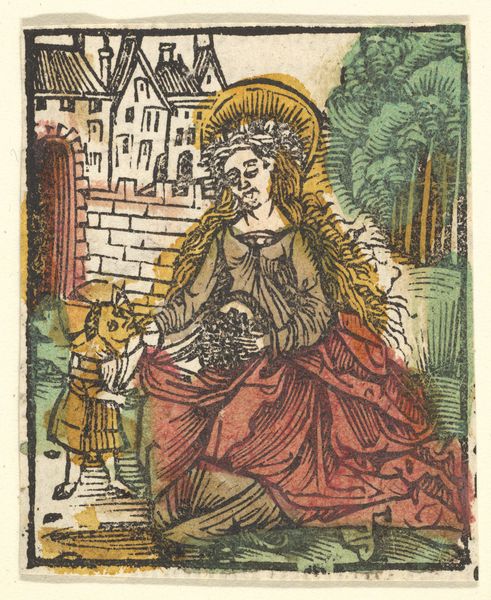
drawing, print, woodcut
#
drawing
#
narrative-art
# print
#
landscape
#
figuration
#
woodcut
#
northern-renaissance
Dimensions: Sheet: 2 3/8 × 1 15/16 in. (6.1 × 4.9 cm)
Copyright: Public Domain
Curator: I find myself drawn to the raw simplicity of "St. Elizabeth (adaptation)," a woodcut crafted between 1512 and 1600 by Hans Baldung. Editor: It has the feel of a slightly wonky stained-glass window! All that lovely bold outline work dividing planes of color… It projects an almost cartoonish vulnerability. I find myself curious as to who St. Elizabeth was as a person! Curator: Indeed! Saint Elizabeth of Hungary was renowned for her compassion and devotion to the poor. Baldung's rendition is compelling when we consider her significance in a socio-political and religious context during the Northern Renaissance. The print itself served to reinforce the importance of charitable giving during a time of upheaval in Europe. Editor: Look at the rendering of the humble child on the left; it feels deeply humanizing, the gentle curve of the landscape drawing the eye upwards towards Elizabeth. But it is clear she carries something under her dress, presumably provisions! Curator: Yes, the distribution of bread was indeed Elizabeth's method of showing compassion and charity to the common folk in an era deeply divided between royalty and peasants. Editor: The economy of the line, it reminds me that this artwork began as a block of wood and all the conceptual work had to occur within Baldung before setting the blade to wood! But also, what agency could she have possessed as a royal turned giver, could we even consider her "distribution of bread" subversive at the time? Curator: An excellent point! While celebrated now, her altruism undoubtedly challenged the entrenched power dynamics of her era, disrupting established norms of the elite. That her narrative would endure as a woodcut printed across a span of centuries speaks to its potential impact and continued importance. Editor: Looking closer now, there is an endearing naivety within the formal architecture and even St. Elizabeth herself is looking slightly perplexed… perhaps reflecting her interior conflict within herself? To provide for all, to the degree necessary. Curator: A Renaissance depiction meant to serve both the devout and the disruptors, what better example could exist than Saint Elizabeth, the champion of charitable giving, presented through Baldung’s arresting use of the woodcut. Editor: It speaks quietly but with strength.
Comments
No comments
Be the first to comment and join the conversation on the ultimate creative platform.













